Tina Lee Cheng, M.D., M.P.H.
- Director, Department of Pediatrics
- Professor of Pediatrics

https://www.hopkinsmedicine.org/profiles/results/directory/profile/0017241/tina-cheng
Uroxatral dosages: 10 mg
Uroxatral packs: 30 pills, 60 pills, 90 pills, 120 pills, 180 pills, 270 pills, 360 pills
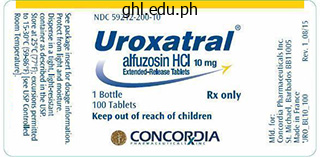
10 mg uroxatral buy mastercard
The presence of bile enhances absorption, however the mechanism of this enhancement is unclear. Dietary iron is predominantly found in the ferric kind, but Fe3+ is extremely insoluble beneath physiologic circumstances. Therefore, throughout uptake, Fe3+ is converted to the Fe2+ form at the apical mobile membrane before it attaches to an acceptor protein within the membrane. Increased ferrireductase activity correlates with enhanced iron uptake induced by iron deficiency and hypoxia. Three main pathways of iron transport throughout the apical membrane have been proposed. It is up-regulated throughout iron deficiency and down-regulated in cases of iron excess. The concept that the transporter liable for dietary iron absorption recognizes other divalent cations agrees properly with observations that Zn2+, Mn2+, Cd2+, and Cu2+ all can inhibit this process. Inorganic iron is converted into its ferrous form on the brush border membrane earlier than transport into the cell. Within the cell, 1 or more iron-binding proteins take up iron and transfer it to the basolateral membrane for delivery across the membrane and subsequent binding to transferrin. Thus, different factors must be concerned in the switch throughout the intestinal epithelium. This large hydrophobic transporter is present in the apical membrane throughout iron deficiency and within the cytoplasm during iron overload, making it a putative candidate for heme-iron transport. This pathway is regulated and is decided by metabolic energy, and it seems to be encouraged by nonessential fatty acids. Once within the enterocyte, expression of the iron-storage protein ferritin is regulated by the intracellular focus of iron. Ferritin synthesis increases when iron is current in extra and decreases when iron stage is low. It acts on a pathway that facilitates a slow accumulation of non-heme dietary iron. The functioning of the shops regulator is of great physiologic importance as a outcome of it prevents iron overload after guaranteeing iron needs are met. The actual molecular mechanism of the shops regulator has not been established, but it has been proposed to contain soluble factors similar to transferrin-bound iron, serum ferritin, serum transferrin, or hepcidin. The erythropoietic regulator is a 3rd regulatory mechanism that adjusts intestinal iron absorption in response to the calls for of erythropoiesis, independent of body iron shops. This regulator should sign instantly between the hematopoietic bone marrow and the duodenum. The stores and erythropoietic regulators are circulating factors that keep iron homeostasis of the complete organism. Basolateral iron uptake from the plasma by cryptal enterocytes plays an necessary position in sensing body iron stores. There is considerable evidence that the iron focus inside the cryptal enterocyte is a vital determinant of iron absorption. The mechanism by which the intracellular iron concentration can respond to body iron needs is poorly understood. It is evident, however, that cells in the crypts of Lieberk�hn all the time express transferrin, and the endocytic mechanism imparts information about physique iron storage based on plasma transferrin saturation. This lag response time most likely correlates with the migration time for proliferating cells in the crypts to differentiate and migrate into functional mature enterocytes of the villi. Thus, the luminal epithelial cells may be preprogrammed in the crypts based on body iron wants. This preprogramming would, in flip, initiate synthesis of iron transport proteins required for dietary iron uptake throughout the membranes of the villus enterocyte. Zinc Zinc is a nutrient of basic biologic importance, with ubiquitous presence in mammalian metabolism. Persons who consume a low-energy food regimen would possibly absorb marginal amounts of zinc, and requirements are elevated throughout pregnancy and lactation. Absorption is impaired by phytates and oxalates in the food plan by way of their chelating properties, and food processing can render zinc less out there for absorption.
Safe 10 mg uroxatral
Intrahepatic cholangiocarcinoma is rare earlier than 40 years of age, and traditionally the worldwide approximate average age at presentation is 50 years. Epidemiologic information point out that the age at presentation has shifted to more than sixty five years. The tumor is hypointense on T1-weighted images and moderately intense on T2-weighted pictures. Percutaneous biopsies additionally carry the risk of peritoneal seeding and are typically averted if the tumor is probably resectable. Criteria for resection include absence of all the next: evidence of extrahepatic metastasis, major portal vein or hepatic artery invasion or encasement, bilateral segmental bile duct involvement, and contralateral hepatic lobar atrophy. Additionally, the patient have to be medically fit to bear surgical procedure and have adequate hepatic reserve. Without clear margins of resection, surgical procedure provides benefits similar to those of endoscopic or biliary drainage. Patients properly chosen for surgical resection obtain a 1- to 2-year median survival and a 29% to 36% 5-year survival fee. Liver transplantation alone or in combination with neoadjuvant and adjuvant chemotherapy ends in unacceptably excessive recurrence charges and fewer than a 50% 5-year survival. Pathology Peripheral cholangiocarcinoma often is a large and solitary tumor, however it may be multinodular. The bile ducts peripheral to the tumor may be dilated, leading to some cases in biliary cirrhosis. Microscopically, cholangiocarcinoma exhibits acinar or tubular buildings that resemble these of different adenocarcinomas. The tumor cells provoke a variable desmoplastic response, and in plenty of tumors, the collagenized stroma could be the most distinguished feature. Distinguishing the tumor from metastatic adenocarcinoma may be tough, and a few specialists have advocated assuming that an adenocarcinoma in the liver is cholangiocarcinoma if no main tumor may be discovered elsewhere. It occurs virtually exclusively in the first 3 years of life; boys are affected twice as usually as ladies. Distant metastases are evident, usually within the lung, in 20% of patients at the initial visit. Liver transplantation performs an rising function because of technical success with live-donor and splitliver transplantation. Angiosarcoma Epidemiology Although rare, angiosarcoma is the most typical malignant mesenchymal tumor of the liver. Pulmonary metastases and, hardly ever, mottled calcification in the tumor could additionally be seen on plain radiography. In early stories, the tumor became evident approximately 20 years after publicity to thorium dioxide (see Chapter 89). Angiosarcomas have occurred after exposures of 11 to 37 years (or after shorter intervals with a heavy initial exposure). Pathology Hepatoblastomas are the malignant derivatives of incompletely differentiated hepatocyte precursors. Their constituents are numerous, reflecting each the multipotentiality of their mesodermal origin and the progressive levels of embryonic and fetal development. Pathologists separate hepatoblastomas into subtypes primarily based on their histopathologic appearance, each with a prognosis that could be danger stratified. The pure fetal type has a wonderful prognosis, whereas the aggressive small-cell undifferentiated tumor has the worst prognosis and is normally assigned probably the most intensive therapeutic interventions. They vary in shade, ranging from tan to grayishwhite, and contain foci of hemorrhage, necrosis, and calcification. Epithelial hepatoblastomas are stable, whereas tumors of the combined variety often are separated into lobules by white bands of collagen tissue. Cells of the second sort are embryonal and are less differentiated than the fetal kind. Mixed hepatoblastomas comprise mesenchymal tissue consisting of areas of a extremely mobile primitive sort of mesenchyme intimately admixed with epithelial elements. Hepatoblastomas could show foci of squamous cells, with or with out keratinization, and overseas body�type giant cells.
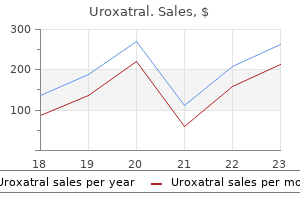
Uroxatral 10 mg buy visa
Unfortunately, portal hypertension attributable to cirrhosis usually persists and progresses regardless of the event of even an intensive collateral circulation. Progression of portal hypertension outcomes from (1) the distinguished obstructive resistance within the liver, (2) resistance within the collaterals themselves, and (3) continued enhance in portal vein inflow. The collateral circulatory mattress develops via a mixture of angiogenesis, the development of latest blood vessels, and dilatation and increased move via preexisting collaterals. Therefore, circulate is reversed in these collateral vessels, and blood flows out of the portal circulation toward the systemic venous circulation. Furthermore, a portal pressure gradient of no much less than 12 mm Hg is thought to be required for varices to bleed; different native components that improve variceal wall rigidity are also needed83 as a end result of not all patients with a portal stress gradient of greater than 12 mm Hg bleed. When the variceal wall thins and the varix will increase in diameter and strain, the tolerated wall tension is exceeded and the varix ruptures. These physiologic observations are manifested clinically by the statement that patients with larger varices (r) in sites of restricted soft tissue support (w), with elevated portal pressure (P), are probably to be at biggest threat for variceal rupture from variceal wall tension (T) that becomes extreme. One notable website during which soft tissue support is limited is at the gastroesophageal junction. The lack of tissue help and high vessel density may contribute to the greater frequency of bleeding from varices at the gastroesophageal junction. A reduction in portal strain reduces the variceal transmural strain gradient, thereby reducing the risk that variceal wall rigidity will turn into excessive and that varices will rupture. Clinically, a reduction within the hepatic venous pressure gradient to lower than 12 mm Hg nearly eliminates the chance of variceal hemorrhage. The modifications in portal stress and native variceal factors, nevertheless, are dynamic and influenced by a selection of physiologic (an improve in intra-abdominal strain, mealinduced increases in portal pressure), diurnal (circadian adjustments in portal pressure), and pathophysiologic (acute alcohol use) components; furthermore, portal stress and esophageal variceal stress may range at different occasions. The catheter can be handed into the hepatic vein through the femoral vein or using a transjugular venous method. By contrast, utilizing the best atrial pressure as a reference for intra-abdominal pressure gives rise to an erroneous estimation of hepatic sinusoidal strain. Total occlusion of the hepatic vein by the inflated balloon to affirm that the balloon is in a wedged place is demonstrated by injecting distinction into the hepatic vein. A sinusoidal pattern ought to be seen, with no collateral circulation to other hepatic veins. Correct positioning of the balloon can be demonstrated by a sharp enhance within the recorded pressure on inflation of the balloon. The stress then becomes regular till the balloon is deflated, when the pressure drops sharply. The consensus is that each one sufferers with cirrhosis of the liver should be screened for esophageal varices by endoscopy. In sufferers in whom no varices are detected on initial endoscopy, endoscopy to display screen for varices should be repeated in 2 to three years. If small varices are detected on the initial endoscopy, endoscopy must be repeated in 1 to 2 years. Various standards have been used to attempt to standardize the reporting of esophageal varices. The finest known of these criteria are those compiled by the Japanese Research Society for Portal Hypertension. The descriptors embrace purple shade signs, colour of the varix, form (size) of the varix, and site of the varix. Of all the aforementioned descriptors, the scale of the varices in the lower third of the esophagus is crucial. Small varices are less than 5 mm in diameter, whereas massive varices are higher than 5 mm in diameter. Patients with giant esophageal varices, Child-Pugh class C cirrhosis (see later), and red color signs on varices have the very best danger of variceal bleeding inside 1 12 months. Therefore, prophylactic therapy to forestall variceal bleeding is recommended in all sufferers with large esophageal varices no matter the presence or absence of red color indicators (see later). Portal Vein Pressure Direct measurement of the strain within the portal vein can additionally be a not often used technique that can be carried out via a percutaneous transhepatic route, transvenous method, or, rarely, intraoperatively (although anesthesia can affect portal pressure). Endoscopic Variceal Pressure Varices rupture and bleed when the increasing pressure of intravariceal strain exceeds variceal wall tension.
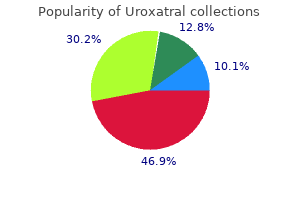

Discount uroxatral 10 mg overnight delivery
Trends in the Intake of Macronutrients for Children (Age 2 yr) and Adults from 1999-2000 and 2007-2008* Intake Total energy (Kcal) Fat (%) Protein (%) Carbohydrates (%) 1999-2000 2223 32. In the United States, fat consumption rose from roughly 34% of whole vitality consumed in the Thirties to round 40% in the late Sixties and Seventies. From 1971 to 2000, the share of energy contributed by fats decreased again to 33%, reflecting partly a couple of 25% improve in complete energy consumption. During the identical period, the share of energy derived from carbohydrate increased from 40% to 50%, and these developments have since remained secure (Table 102-1). In the past a quantity of a long time, emphasis on significance of minimizing dietary fats to shield against weight problems and coronary artery illness, combined with the growing availability of processed carbohydrates and sugars, has led to increased consumption of low-fat, high-carbohydrate foods. The associated decline in fat consumption, however, correlated with a rise rather than a decrease within the prevalence of weight problems, especially amongst children, a phenomenon referred to because the "American paradox. Added to these are the elevated consumption of refined sugars and corn sweeteners and the dependence on processed meals, which accommodates high concentrations of added sugar and fats. Humans absorb 20% to 80% of cholesterol delivered to the intestine by intake (300 mg/day) or by way of the bile (1 g/day). Phospholipid ingestion is 2 to eight g/day, and the most abundant dietary phospholipid is phosphatidyl choline (lecithin), enriched in linoleate and arachidonate. Phospholipids within the duodenal lumen (10 to 22 g/day) exceed intake because of contribution from endogenous sources, particularly bile. In addition to saturation, hydrogenation results in cis to trans isomerization of double bonds. Lipids are efficiently absorbed by the small intestine, and solely 5% of ingested lipid is excreted in the stool. Events that precede meals intake, similar to seeing, smelling, or thinking of food, induce salivary and gastric secretions by way of the autonomic nervous system and stimulate pancreatic and biliary secretions through the vagus nerve. According to the National Institutes of Health, approximately 25% of Americans are non-tasters, 50% are medium tasters, and 25% are supertasters. Great progress has been lately completed within the identification of style receptors for varied sensations similar to candy, salty, and bitter, enhancing our understanding of the interaction between heredity and the setting in figuring out food preferences and intake patterns. Humans show large variations within the orosensory detection thresholds for dietary fats. In humans, extreme dietary fats consumption attenuates the nutrient-sensing response in the oral cavity, which may affiliate with adjustments in diet and weight. Accumulating evidence supports gustatory cues in fat notion much like these for the 5 fundamental tastes (salty, bitter, umami, candy, bitter). This in turn triggers calcium flux from membrane store-operated calcium channels, leading to neurotransmitter launch. These processes are described within the preceding part on An Overview of Gastrointestinal Integration. Panel A, Diagrammatic representations of bile salt molecules (top) oriented at an oil-water interface with its hydrophobic sterolic backbone in the oil section, and its hydrophilic hydroxyl and both taurine or glycine conjugates in the aqueous section. At above their important micellar concentration, bile salts aggregate as simple micelles in water, with their hydrophilic groups dealing with into the aqueous phase (bottom 2 diagrams). Panel B, Dispersion of lipolytic merchandise into lamellae on the floor of the oil part, and from there into vesicles and micelles, is shown. Mixed micelle formation is determined by pH, presence or absence of lipids, and the types of bile salts current (see Chapter 64). Mixed micelles are about 50 to 80 nm in diameter and, in contrast to emulsion droplets, are too small to scatter gentle; hence, micellar options are clear. The phospholipid secreted in bile enlarges the blended micelles, enhancing capability for fat dissolution. Lipid-containing particles apart from bile salt micelles might participate in mucosal switch of lipid. These vesicles normally quickly release their lipid to the micelles when enough concentrations of bile salts are present, and micelles, normally rather more widespread than lipid vesicles, are the major route for lipid visitors. In the absence of colipase, bile salts on the floor of the emulsion inhibit lipase exercise.
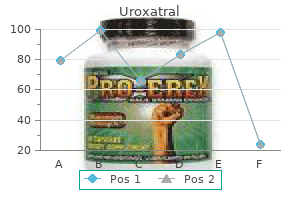
Buy uroxatral 10 mg low cost
Eligibility and safety of triple remedy for hepatitis C: Lessons realized from the first expertise in a real world setting. Dual therapy with the nonstructural protein 5A inhibitor, daclatasvir, and the nonstructural protein 3 protease inhibitor, asunaprevir, in hepatitis C virus genotype 1b-infected null responders. Sustained virological response to interferon plus ribavirin reduces liver-related problems and mortality in patients coinfected with human immunodeficiency virus and hepatitis C virus. A randomized controlled trial of pretransplant antiviral therapy to forestall recurrence of hepatitis C after liver transplantation. Progression of liver fibrosis in post-transplant hepatitis C: Mechanisms, assessment and remedy. Interleukin-28B polymorphisms are related to histological recurrence and therapy response following liver transplantation in patients with hepatitis C virus an infection. Cyclosporine A inhibits hepatitis C virus nonstructural protein 2 through cyclophilin A. Antiviral remedy of recurrent hepatitis C after liver transplantation: Predictors of response and long-term outcome. Clinical advantages of antiviral remedy in sufferers with recurrent hepatitis C following liver transplantation. Safety and efficacy of protease inhibitors to treat hepatitis C after liver transplantation, a multicenter experience. Management of anemia induced by triple therapy in patients with chronic hepatitis C: Challenges, opportunities and recommendations. Multicenter experience utilizing telaprevir or boceprevir with peginterferon and ribavirin to deal with hepatitis C genotype 1 after liver transplantation. Sofosbuvir and daclatasvir mixture remedy in a liver transplant recipient with severe recurrent cholestatic hepatitis C. Since that time, most of the patients with extreme liver harm have died due to the an infection, and heaps of of those with initially mild hepatitis have developed advanced liver disease and its problems. In addition, the nucleic acid of satellite viruses is distinct from the nucleic acid of helper viruses. Fluctuating activity of each or of one of many two viruses was noted in more than 50% of the patients. Prevalence, correlates, and viral dynamics of hepatitis delta amongst injection drug customers. A class of medication referred to as prenylation inhibitors are the closest to medical software. Epidemiology, pathogenesis and administration of hepatitis D: Update and challenges forward. Clinical end result of acute and continual hepatitis delta over time: A long-term follow-up examine. Acute hepatitis delta virus infection in Italy: Incidence and risk components after the introduction of the common anti-hepatitis B vaccination campaign. Antibodies to delta antigen in asymptomatic hepatitis B surface antigen-reactive blood donors in the United States and their affiliation with other markers of hepatitis B virus. Hepatitis D virus an infection in Illinois state services for the developmentally disabled. Characterization of a hepatitis B and hepatitis delta virus receptor binding site. Entry of hepatitis delta virus requires the conserved cysteine residues of the hepatitis B virus envelope protein antigenic loop and is blocked by inhibitors of thiol-disulfide change. Role of two forms of hepatitis delta virus antigen: Evidence for a mechanism of selflimiting genome replication. Geographic distribution and genetic variability of hepatitis delta virus genotype I. Molecular epidemiological and scientific features of hepatitis D virus in a unique triple hepatitis viruses (B, C, D) endemic community in Taiwan. Hepatitis B virus and hepatitis delta virus genotypes in outbreaks of fulminant hepatitis (Labrea black fever) in the western Brazilian Amazon region.
10 mg uroxatral purchase with amex
Hepatobiliary complications in patients with human immunodeficiency virus infection. Timing of cholecystectomy for biliary pancreatitis: Do the data assist current tips Lack of consensus on the function of endoscopic retrograde cholangiography in acute biliary pancreatitis in revealed meta-analyses and guidelines: A systematic evaluation. Laparoscopy for appendicitis and cholelithiasis throughout pregnancy: A new commonplace of care. Complications of gallstones: the Mirizzi syndrome, gallstone ileus, gallstone pancreatitis, problems of "lost" gallstones. Asymptomatic cholelithiasis in children with sickle cell disease: Early or delayed cholecystectomy High incidence of cholelithiasis in older sufferers with homozygous betathalassemia. Increased morbidity in surgical patients present process secondary (incidental) cholecystectomy. Are we coaching our residents to perform open gall bladder and common bile duct operations Randomised trial of laparoscopic exploration of frequent bile duct versus postoperative endoscopic retrograde 117. Transcystic common bile duct exploration in the management of sufferers with choledocholithiasis. Surgical administration of bile duct injuries sustained throughout laparoscopic cholecystectomy: Perioperative results in 200 sufferers. Long-term outcome of biliary reconstruction for bile duct accidents from laparoscopic cholecystectomies. Relationship between persistence of stomach symptoms and successful outcome after cholecystectomy. Retained gallbladder/ cystic duct remnant calculi as a reason for postcholecystectomy pain. Diagnosing and treating sphincter of Oddi dysfunction: A critical literature evaluation and reevaluation. Systematic evaluate: Sphincter of Oddi dysfunction-non-invasive diagnostic methods and long-term outcome after endoscopic sphincterotomy. Transduodenal sphincteroplasty in the management of sphincter of Oddi dysfunction and pancreas divisum within the fashionable period. Cholecystectomy protects towards extrahepatic bile duct most cancers: Is this a results of the elimination of gallstones As shown in Table 67-1, acalculous biliary pain is mostly a dysfunction of young, predominantly female, ambulatory sufferers and mimics calculous biliary ache. Acute acalculous cholecystitis is typically a disease of immobilized and critically sick older males with coexisting vascular illness. Three sometimes asymptomatic situations of the gallbladder-cholesterolosis, adenomyomatosis, and gallbladder polyps-are also reviewed. The localization of pain to the right hypochondrium or radiation to the right shoulder is the most specific finding for a biliary tract origin. Between attacks, the physical findings are normally regular, with the potential exception of residual upper belly tenderness. In comparison, the administration of acalculous biliary ache represents a significant problem. In patients with acalculous biliary ache, symptomatic improvement following cholecystectomy is more variable. In 1 sequence of more than one hundred sufferers, 83% have been female, and the imply age was approximately 30 years. Stimulated duodenal bile from sufferers with acalculous biliary ache is more dilute with respect to both bile acids and phospholipids than bile from patients with gallstones or from control girls without biliary symptoms.
Uroxatral 10 mg generic free shipping
The phrases efferent and motor in regard to neural supply are used to describe pathways that conduct signals toward the "effector," in this case the small intestinal clean muscle. Although the importance of motor innervation for motility is self-evident, the pivotal function of afferent operate in determining motor 1682 Section X SmallandLargeIntestine the myenteric plexus consists of ganglia that are spaced at common intervals and connected by a network of interganglionic fascicles; this main network is called the primary plexus. Within this major structure, smaller branches of nerve bundles come up from the primary plexus and form the secondary plexus, and still smaller branches kind the tertiary plexus. The submucosal plexus has 2 layers, 1 close to the mucosa and one other nearer to the circular muscle layer. The myenteric plexus also accommodates the cell our bodies of intrinsic afferent neurons that discharge in response to mechanical stimulation of the muscle layer induced by muscle exercise or stretch. Intrinsic afferent neurons that reply to mechanical stimulation of the mucosa also are believed to exist, based on enteric reflexes seen in extrinsically denervated preparations. A more detailed account of the operate and function of intrinsic afferent neurons may be found in a review by Furness and coworkers. These ileal myenteric neurons show rapidly adapting responses to mechanical stimulation, whereas colonic neurons show slowly adapting responses, which suggests these neurons can directly encode dynamic adjustments in pressure in response to phasic or tonic contractions. Schematic illustration of relationships among elements of small intestinal motor management system. The significance of the extrinsic afferent innervation in sensory signaling is emphasised by the statement that at least 80% of vagal fibers are afferent somewhat than efferent. The latter 2 teams may be additional subdivided into excitatory and inhibitory motor neurons and ascending and descending interneurons, respectively. Together these 3 groups form complicated networks which are answerable for coordinating intestinal motility. Within this community, specific ascending and descending circuits are synchronously activated in response to luminal contents. Contractions are the resultant process of ascending pathways, with ascending interneurons synapsing onto excitatory motor neurons, whereas relaxations result from descending interneuron activation of inhibitory motor neurons. Other classes of neurons, including secretomotor and vasomotor neurons and motor neurons to endocrine cells, are acknowledged but not thought of additional on this chapter. Additional distinct subgroups of enteric neurons are actually well characterised both structurally and functionally and are reviewed intimately elsewhere. The ganglia in the submucosal and myenteric plexuses are related by interganglionic fascicles. Unlike skeletal muscle, no specific neuromuscular junctions are present in small intestinal clean muscle, although multiple varicosities alongside the motor axons in all probability characterize specialized areas of neurotransmission. Interneurons that play an additional sensory position have been identified, and respond on to mechanical adjustments in muscle length, somewhat than muscle tone or tension. Schematic illustration of varied subtypes of extrinsic sensory afferent nerve fibers that innervate the small gut through vagal and spinal nerve pathways. The pathway of small intestinal vagal afferent innervation is comparatively easy. The vagal afferent neurons have endings within the intestinal wall and cell bodies throughout the nodose and jugular ganglia, which deliver enter directly to the brainstem. Spinal afferent neurons have their cell our bodies all through the thoracic dorsal root ganglia and enter the spinal wire through the dorsal roots; they synapse primarily on neurons of the superficial laminae of the spinal grey matter. In basic, vagal afferents have lower mechanical activation thresholds and show saturated responses at higher intensities, whereas spinal afferents are activated at greater thresholds. These completely different stimulus response profiles of vagal and splanchnic mechanoreceptors are usually interpreted as proof that vagal afferents subserve physiologic regulation corresponding to fullness and satiety, whereas spinal afferents mediate discomfort, bloating, and ache. Extraluminal afferent fibers have responsive endings on blood vessels in the outer serosal layer and in the mesenteric connections. Muscular afferents show maintained responses to distention of the small gut and signal every contractile event, giving rise to the time period in-series tension receptors. These endings are in intimate contact with the connective tissue capsule and enteric glial cells that surround the myenteric ganglia, they usually have 1684 Section X SmallandLargeIntestine been hypothesized to detect mechanical shearing forces between the orthogonal muscle layers.
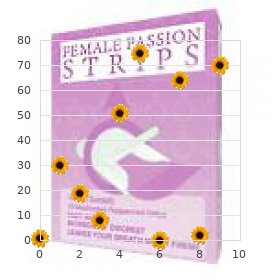
10 mg uroxatral overnight delivery
These injuries commonly happen throughout an in any other case uneventful cholecystectomy and could additionally be unnoticed by the surgeon. If the bile duct has been completely occluded, jaundice develops quickly within the early postoperative interval after cholecystectomy. In the second pattern, the injury is manifested by the development of bile ascites that outcomes from transection of an extrahepatic bile duct, ineffective placement or dislodgement of cystic duct ligatures, or a bile leak from the gallbladder fossa as a outcome of a divided cystohepatic duct or duct of Luschka. A bile leak is often related to an infected bile collection in the subhepatic space. In the third pattern, partial bile duct obstruction leads to intermittent episodes of pain, jaundice, or cholangitis, normally inside two years of the cholecystectomy. In the early postoperative period following laparoscopic cholecystectomy, the clinician should suspect the potential of bile duct injury in any patient with persistent abdominal ache. With the primary sample (A and B), the affected person could current with a biloma or bile ascites from a cystic duct stump leak (arrow in A) or a bile leak from a duct of Luschka (arrow in B). With the second sample (C and D), the patient presents with jaundice, with or without a bile leak, as a result of excision of the bile duct secondary to misinterpretation of the bile duct for the cystic duct. These issues usually contain injury to the confluence of the hepatic ducts and to the right hepatic artery as properly. With the third pattern (E and F), the affected person presents with jaundice attributable to a stricture resulting both from a surgical clip positioned on the bile duct instead of the cystic duct or from a thermal harm. The stenosis might happen as a result of trauma corresponding to passage of gallstones, instrumentation, pancreatitis, or infection. Functional or motility problems have been referred to as biliary or sphincter of Oddi dyskinesia and ampullary spasm. Biliary manometry in these patients reveals elevated sphincter stress resulting from abnormal tonic or phasic easy muscle contractions. The mixture of biliary-type pain, abnormal liver biochemical test levels, and a dilated bile duct is highly predictive of a response to endoscopic sphincterotomy. Selected sufferers might require transduodenal sphincteroplasty and septoplasty (see Chapter 63). Other patients have persistence of right higher quadrant or epigastric belly pain. A small proportion of sufferers with postcholecystectomy symptoms current with extreme stomach pain, jaundice, or emesis; investigation is much more likely to reveal a distinct, treatable cause in this group of sufferers than in those with mild or nonspecific signs. If the signs come up early within the postoperative period, bile peritonitis secondary to iatrogenic biliary damage have to be suspected. The clinician should fastidiously think about the risk of nonbiliary causes of ache and direct the analysis appropriately. Choledocholithiasis Bile duct stones are the most common explanation for postcholecystectomy signs. They may be residual stones missed at the time of cholecystectomy or, less frequently, stones that have formed primarily within the bile duct. Liver biochemical check values, particularly the alkaline phosphatase degree, may be elevated. Whether a causal relationship exists between gallbladder disease or its treatment and the development of these malignancies is unclear. Common environmental components, perhaps dietary, may affect the charges of all these diseases. On the other hand, alterations in the composition of bile in patients with gallstones may influence the event of carcinoma. Moreover, cholecystectomy will increase the enterohepatic circulation of bile acids, which will increase mucosal exposure to potentially carcinogenic secondary bile acids corresponding to deoxycholic acid (see Chapter 64). Cystic Duct Remnant In some sufferers, the trigger of postcholecystectomy symptoms has been attributed to pathology in the cystic duct remnant (or stump). Although the existence of such a syndrome has been controversial, in a single randomized Biliary Tract Cancer the strongest association between gallstones and cancer is with cancers of the biliary tract itself, significantly gallbladder carcinoma (see Chapter 69). Most sufferers with gallbladder cancer have gallstones, and epidemiologic knowledge present a strong Chapter sixty six TreatmentofGallstoneDisease 1151 relationship between the two diseases. The danger of gallbladder cancer is larger in sufferers with giant gallstones than in these with small gallstones, in these with multiple gallstones than a single gallstone, and in Native Americans. A cost-effectiveness analysis of intraoperative cholangiography in the prevention of bile duct injury throughout laparoscopic cholecystectomy. Association between cholecystectomy and intestinal most cancers: A nationwide document linkage examine.
Narkam, 30 years: Such advanced gallbladder disease could also be current even when local and systemic manifestations are unimpressive.
Gonzales, 31 years: Epidemiology the prevalence of adenomyomatosis of the gallbladder varies greatly according to the standards used for analysis and whether resected gallbladders or post-mortem specimens are examined.
Kerth, 36 years: Association of coffee and caffeine consumption with fatty liver illness, nonalcoholic steatohepatitis and diploma of hepatic fibrosis.
Moff, 63 years: The presence of coronary heart failure significantly will increase the chance that a drop in cardiac output from any cause will lead to ischemic hepatitis.
Phil, 55 years: Four weeks after an infection, adult worms disintegrate, releasing eggs into the hepatic parenchyma and producing an intense inflammatory response with macrophages, eosinophils, and giant cells.
Daro, 43 years: A defect in acidification of bile can also be induced by gallbladder inflammation or the reduced buffering capability of sialic acid and sulfate moieties in the mucin gel.
Enzo, 50 years: Other musculoskeletal issues include osteoporosis and osteochondritis dissecans.
Arokkh, 35 years: Clinicopathologic findings and outcomes of liver transplantation using grafts from donors with unrecognized and strange ailments.
Fedor, 32 years: Increased endothelial nitric oxide synthase activity within the hyperemic vessels of portal hypertensive rats.
Grubuz, 47 years: Gross Appearance When the gallbladder is inspected visually on the time of laparotomy or laparoscopy, a prognosis of cholesterolosis may be made in 20% of the circumstances on the premise of the gross appearance of the gallbladder mucosa as seen by way of the translucent serosal surface.
Torn, 38 years: The management of high-grade hilar strictures by endoscopic insertion of self-expanding steel endoprostheses.
Grok, 37 years: It represents an extension of the visceral peritoneum and mesentery because it envelops the intestine.
Ortega, 60 years: Nevertheless, azathioprine has been associated with congenital malformations in pregnant mice, and these defects have included cleft palate, skeletal anomalies, hydrops fetalis, reduced thymic size, anemia, and hematopoietic despair.
Bufford, 39 years: Liver injury is attributable to proliferation of organisms within hepatocytes and provocation of an immune response.
10 of 10 - Review by D. Ilja
Votes: 245 votes
Total customer reviews: 245
References
- Chahal R, Gogoi N, Sundaram S: Is it necessary to perform urine cytology in screening patients with haematuria?, Eur Urol 39:283-286, 2001.
- Miller CS, Danaher RJ. Asymptomatic shedding of herpes simples virus (HSV) in the oral cavity. Oral Surg Oral Med Oral Pathol Oral Radiol Endod 2008;105:43-50.
- Pearle AD, Scanzello CR, George S, et al. Elevated high- sensitivity C- reactive protein levels are associated with local inflammatory findings in patients with osteoarthritis. Osteoarthritis Cartilage 2007; 15:516-23.
- Pickhardt PJ, Hassan C, Halligan S, et al. Colorectal cancer: CT colonography and colonoscopy for detection- systematic review and meta-analysis. Radiology 2011;259(2):393-405.
- Criscuolo C, Chessa L, Di Giandomenico S, et al. Ataxia with oculomotor apraxia type 2: a clinical, pathologic, and genetic study. Neurology. 2006;66:1207-1210.
- Fernihough J, Gentry C, Malcangio M, et al. Pain related behaviour in two models of osteoarthritis in the rat knee. Pain 2004; 112:83-93.
- Nagler A, Pollack S, Hassoun G, et al. Human pleuropulmonary gnathostomiasis: a case report from Israel. Isr J Med Sci 1983;19(9):834-7.
- Crough T, Khanna R. Immunobiology of human cytomegalovirus: from bench to bedside. Clin Microbiol Rev. 2009;22:76-98.


